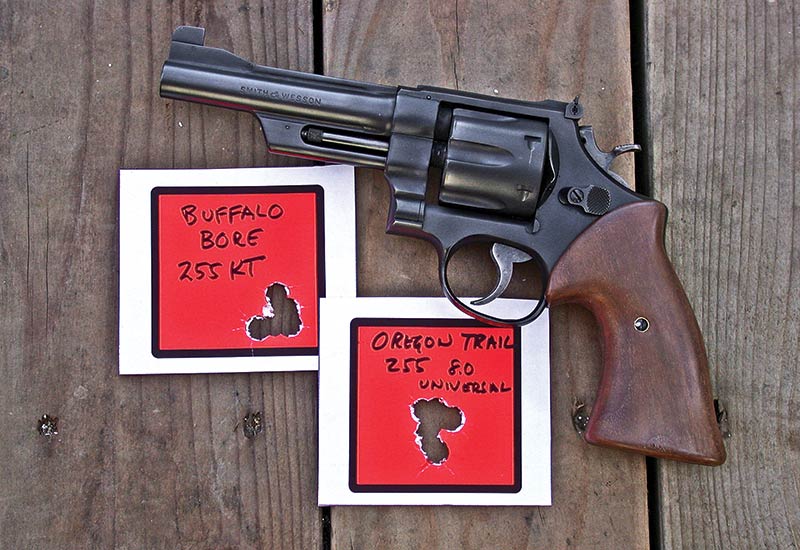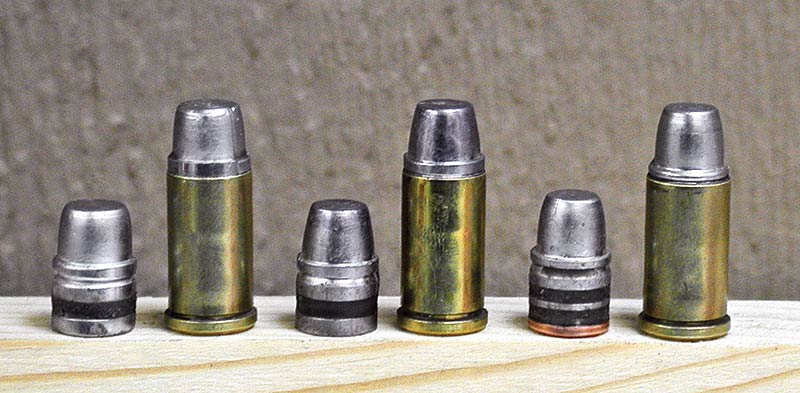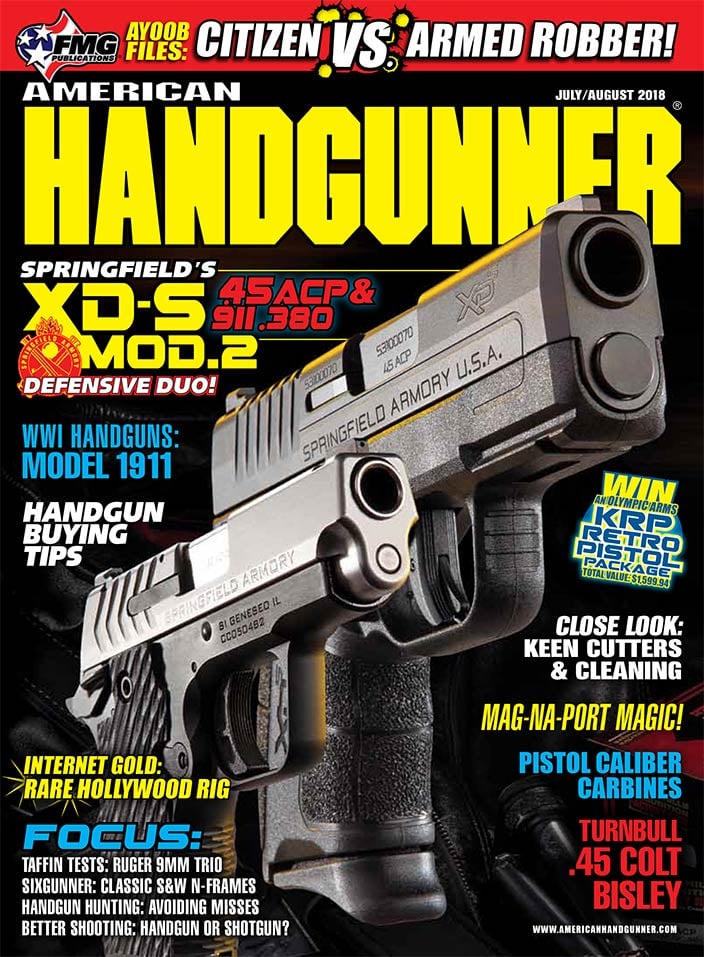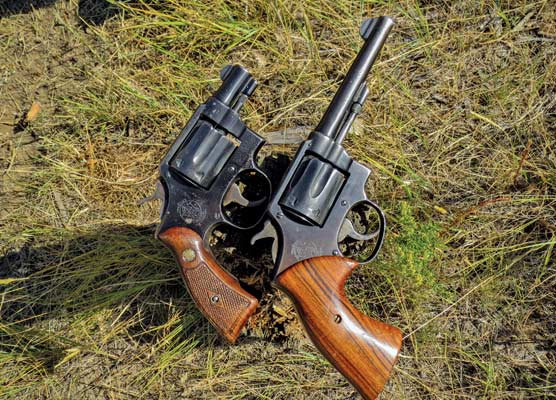Classic S&W N-Frames
The 1950 Target .45 Auto Rim
One of our local gunshops, Boise Gun Company, had two 1950 Targets in the case one day. They came from the same collection, both had 61/2″ barrels and S&W Diamond Magna stocks, however they were not both .44 Specials. One was marked “45 CAL. MODEL 1950.” When S&W introduced the 1950 Models with the new short action and improved rear sight they not only made them in .44 Special but also chambered them for .45 ACP/.45 Auto Rim. These are even rarer than those found in .44 Special. I ended up with both after digging up some trading stock!
The roots of the 1950 Target .45 go way back, all the way to 1917. As we prepared to enter WWI we were lacking in firearms and it was immediately found the 1911 .45 could not be manufactured fast enough. An engineer at S&W came up with a brilliant idea — the half moon clip. The standard 2nd Model Hand Ejector was chambered in .45 ACP and by loading three rounds in these new clips, reloading and ejection was made easy and reliable.
The Big Idea
In the early 1920s Remington came up with a second excellent idea concerning the 1917. Instead of loading .45 ACPs into half moon clips, Remington decided to simply add a rim to the .45 ACP case. The result was the .45 Auto Rim (AR). It was basically loaded with the same bullets and specifications as the .45 ACP, however over the years we’ve learned the .45 Auto Rim is perfectly capable of handling the same bullets used in the .45 Colt and can match it in performance with some loads.
My friend the late Jimmy Clark was one of the top pistol marksmen of all time and he was also a superb gunsmith. He won many pistol matches and also developed many of the techniques and upgrades used by pistolsmiths today. In the late 1940s/early 1950s bullseye shooting was king. The standard match called for a .22, a Centerfire and a .45 to compete. Jimmy customized a Model 1917 to shoot the .45 phase. This was before so many pistolsmiths, including Clark, turned their talents to turning the 1911 Government Model into a target pistol. When S&W brought out the 1950 Target in .45 Jimmy bought two of them and was disappointed to find they wouldn’t shoot his cast bullet loads.
He complained loudly to S&W and as a result the 1955 Target arrived. The latter had several improvements, including a heavier bull barrel, target hammer and trigger, and a barrel cut to better handle cast bullets. The resulting 1955 Target is almost a dead ringer for the .44 Magnum, arriving in late 1955 with the same target hammer, trigger and heavy bull barrel.
I’ve always heard the story of the 1950 Target .45 not being able to handle cast bullet loads and someday I wanted one just to see for myself. You know how some days seem to take forever to get here, however mine finally arrived with the spotting of those two 1950 Target Models at Boise Gun. In 1950 Jimmy Clark was using the same cast bullets used in 1911s and these bullets are normally sized to 0.451″. When I put pin gauges through the cylinder throats of the 1950 Target I had, I found every one of them measured 0.455″. Perhaps that’s the reason they wouldn’t shoot cast bullets very well! I sized my bullets to 0.454″ and the problem was basically solved.
Versions And Loads
The Model 1950 Target .45 is one of three target version S&W sixguns of 1950. One of the others was, of course, the .44 Special, however the .38/44 Outdoorsman also received the improvements of 1950, so all three are basically the same gun in different chamberings.
The .45 version came standard with checkered hammer, serrated trigger, Patridge front sight and diamond Magna stocks. My example is not totally standard as it has a target trigger and hammer plus a square red bead in the face of the Patridge post front sight blade. I don’t know if this is factory or was added later. Although for normal use I prefer the slim barrel of the 1950 Target whether chambered in .44, .45 or .38, I can see why target shooters would prefer the heavier barrel of the 1955 Model. The extra weight just seems to help the sights to hang right on-target.
I have two favorite bullets for use in the .45 Auto Rim. One is from RCBS and was designed for use in the Colt Single Action. It’s a semi-wadcutter patterned after the Keith bullet and when using my wheelweight alloy they cast out at 281 grains. Even loaded over 6.0 grains of Universal at 865 fps this is still an awesome load from the old Auto Rim.
My second favorite bullet is from Lyman, designed specifically for the .45 AR although it’s also a superb hunting bullet in the .45 Colt. Lyman catalogs it as #452490GC, the GC standing for gas check. This one weighs 255 grains and I also load it over 6.0 grains of Universal for over 880 fps. This one is also quite accurate, with groups running right at 1″.
1955 Target
The 1955 Target was put forth as an improvement over the 1950 Target and it was in many ways. However, my example has the same .455″ throats found in the 1950 Target, meaning neither one will perform very well with hardball. However even hard cast Oregon Trail bullets sized to .452″ work quite well.
The 1950 Target is rarely found in .45 Colt, however the 1955 Target, which became the Model 25, also had a spin off Model 25-5 chambered in .45 Colt. When my friend Paco Kelly gave me a 61/2″ barrel from a 1950 Target years ago I put it away hoping to someday use it as the basis for a custom sixgun. I finally sent it off with a Highway Patrolman to gunsmith John Gallagher to have it made into a .45 Colt.
There are two problems that can hamper such a conversion. Some of the .357 Magnum cylinders have bolt notches too deep to safely allow conversion to .45 Colt, and secondly the 1950 Target barrels, at least as reported over the decades, would not necessarily handle cast bullets. If it was possible, I asked Gallagher to build a 5″ Perfect Packin’ Pistol in .45 Colt.
He re-chambered the cylinder, cut the barrel to 5″ and re-set the front sight while doing a beautiful job of tapering the rib on top of the barrel to match up with the narrower ramp of the front sight. He tuned the action, set the trigger pull at a beautiful creep-free three pounds, and re-finished the barrel to match the matte blue finish of the original Highway Patrolman. I added an old pair of Skeeter Skelton Bearhug stocks.
Everything worked out perfectly! Using hard-cast bullets or even soft-swaged lead bullets makes no difference to this .45 — it simply puts them all in one hole. Not only do my carefully tailored homebrewed loads do this, Buffalo Bore’s factory load with a 255-gr. commercial cast SWC Keith-style bullet cuts one ragged hole, with a muzzle velocity right at 1,000 fps. It’s not an original .45 Colt 1950 Target by any means however that makes no difference to me, as a collectible to me is a sixgun that shoots well.
Some of you may wonder why I choose the .44 Special when there are so many .44 Magnums around. Others won’t understand why anyone would even bother with the .45 Auto Rim or even the .45 Colt in a custom 1950 Target. The reason is simple. These are all great cartridges, and actually decisions like this don’t have to be explained to those who understand. If you have a real sixgunner’s heart — you understand perfectly.









